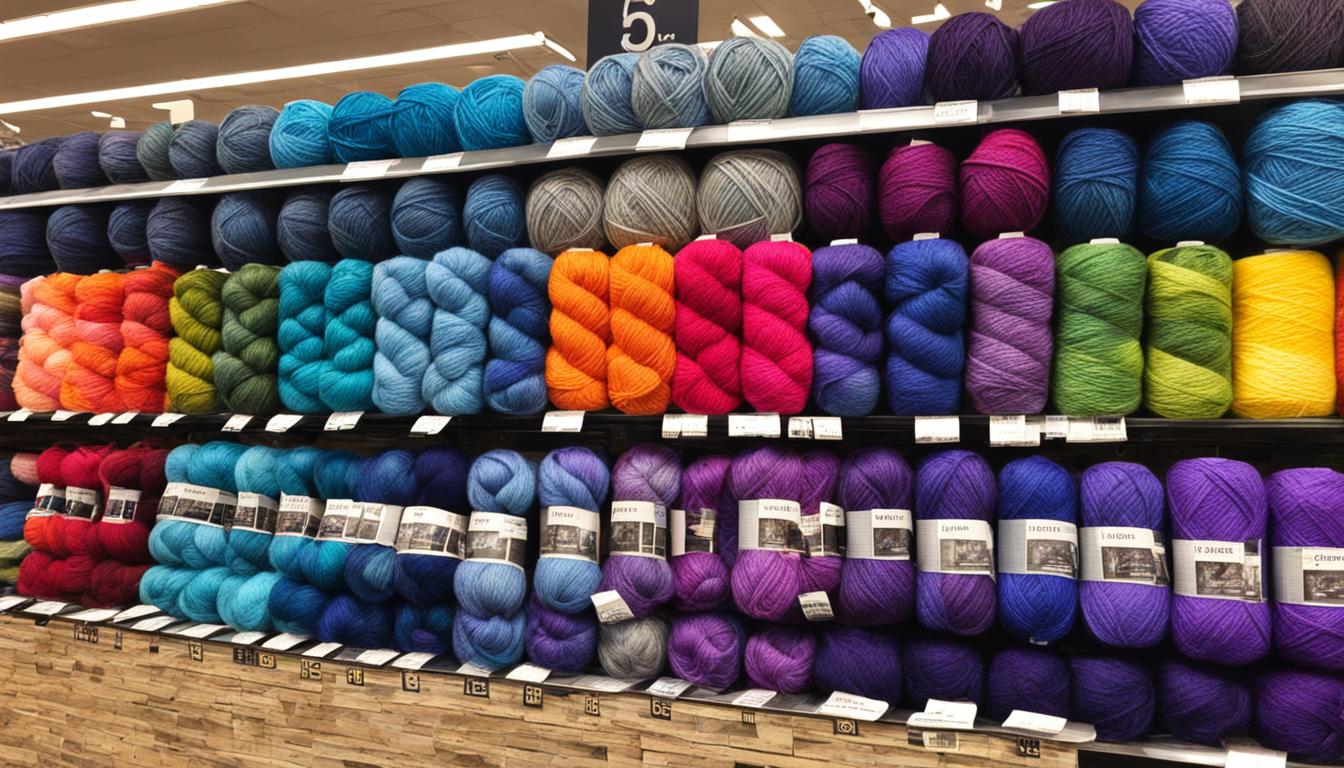When it comes to crafting, acrylic yarn is a popular choice for many DIY enthusiasts. It’s affordable, accessible, and comes in a wide range of colors. But have you ever wondered if acrylic yarn is actually harmful? Does it pose any health risks or safety concerns? Let’s dive into the topic and explore the potential risks and effects of using acrylic yarn.
Key Takeaways:
- Acrylic yarn is not considered sustainable and requires a lot of energy to produce.
- The manufacturing process of acrylic yarn involves the use of toxic substances.
- Washing acrylic fabrics releases microplastics into the environment.
- Acrylic yarn is not biodegradable.
- Consider the potential health and environmental impacts when making choices about using acrylic yarn.
The Sustainability of Acrylic Fabrics
When considering the sustainability of fabrics, acrylic fabrics often raise concerns due to their environmental impact. The manufacturing process of acrylic fabrics is known to be energy-intensive, consuming significant resources.
Moreover, the production of acrylic fabrics involves the use of toxic chemicals. These chemicals can have adverse effects on both the environment and human health. The release of toxic substances during the manufacturing process contributes to pollution and poses risks to ecosystems.
Another sustainability issue associated with acrylic fabrics is the release of microplastics during washing. Microplastics are tiny plastic particles that can find their way into water bodies, causing pollution and harming marine life. Washing acrylic fabrics contributes to the growing problem of microplastics pollution, further highlighting the impact of these fabrics on the environment.
It is also important to note that acrylic fabrics are not biodegradable. This means that once these fabrics are discarded, they do not break down naturally over time. Instead, they persist in the environment, adding to the accumulation of waste.
The Environmental Impact of Acrylic Fabrics
The environmental impact of acrylic fabrics extends beyond their manufacturing and end-of-life stages. The energy-intensive production process of acrylic fabrics contributes to greenhouse gas emissions and the depletion of natural resources. The use of fossil fuels as a raw material for acrylonitrile, a key component of acrylic fabrics, further exacerbates the environmental impact.
With the growing concern for sustainability and environmental conservation, it is essential to explore alternatives to acrylic fabrics. Embracing more sustainable fabric options, such as natural fibers or recycled materials, can help reduce the negative environmental impact associated with acrylic fabrics.
| Key Sustainability Aspects | Acrylic Fabrics | Alternatives |
|---|---|---|
| Energy Consumption | High | Depends on the material, but can be lower |
| Toxic Chemicals | Used in manufacturing | Can be avoided or minimized in alternative materials |
| Biodegradability | Not biodegradable | Depends on the material, but some fibers can be biodegradable |
| Microplastics | Released during washing | Depends on the material, but some fibers shed fewer microplastics |
Considering the sustainability of fabrics is crucial for a more environmentally conscious approach to textile consumption. By choosing more sustainable alternatives and making informed decisions about the fabrics we use, we can contribute to a more sustainable future.
Sourcing of Acrylic Fabrics
Acrylic fabrics, popular for their softness and affordability, are widely used in the textile industry. However, the production of acrylic fabrics relies heavily on the sourcing of raw materials, particularly acrylonitrile. Typically, acrylonitrile is produced from nonrenewable fossil fuels, which raises concerns about the unsustainability of this process.
The production of acrylonitrile from fossil fuels is not only depleting nonrenewable resources but also contributing to environmental pollution. The extraction and processing of fossil fuels release greenhouse gases and pose risks to local ecosystems.
To address these concerns, researchers and industry experts are exploring alternative raw materials for acrylonitrile production. One promising option is renewable biomass. Biomass, such as plant residues and waste materials, can be converted into acrylonitrile through bio-based processes.
This shift towards renewable biomass as a raw material for acrylonitrile production offers potential benefits in terms of sustainability. Unlike fossil fuels, biomass resources are renewable and can be replenished through responsible agricultural practices. Additionally, the production of acrylonitrile from renewable biomass has the potential to reduce carbon emissions and minimize environmental impacts.
While this alternative sourcing method shows promise, further research and development are needed to optimize the production process and ensure its feasibility on a larger scale. Collaborations between industry, academia, and government bodies can accelerate the advancement of bio-based acrylonitrile production and pave the way for a more sustainable future in the acrylic fabric industry.
The Transition to Renewable Biomass
The use of renewable biomass as an alternative raw material for the production of acrylonitrile has gained attention in recent years. Researchers and companies are exploring various biomass sources and conversion technologies to create a more sustainable supply chain for acrylic fabrics.
Bio-based acrylonitrile production involves converting biomass feedstocks, such as agricultural residues, woody biomass, or energy crops, into acrylonitrile. These processes typically utilize fermentation or chemical conversion techniques to extract the desired compound from the biomass feedstock.
One advantage of using renewable biomass is the reduced reliance on nonrenewable fossil fuels. By transitioning to a biomass-based supply chain, the acrylic fabric industry can contribute to a more sustainable and eco-friendly ecosystem.
Additionally, the production of acrylonitrile from renewable biomass offers the opportunity to support local agriculture and rural economies. The cultivation and processing of biomass feedstocks can create jobs and generate income for communities, contributing to sustainable development.
As the demand for sustainable and environmentally friendly textiles continues to grow, the use of renewable biomass as a raw material for acrylic fabrics represents an important step towards a greener future.

The Importance of Sustainable Sourcing
“By transitioning from the production of acrylonitrile from fossil fuels to renewable biomass, the acrylic fabric industry can reduce its carbon footprint and mitigate the environmental impact associated with nonrenewable resource extraction and processing.”
The sourcing of raw materials plays a critical role in determining the overall sustainability of acrylic fabrics. As consumer awareness and demand for sustainable textiles increase, it becomes vital for manufacturers to adopt responsible sourcing practices.
Switching to renewable biomass as a raw material for acrylic fabrics holds great promise in addressing the unsustainability of acrylonitrile production from fossil fuels. However, it is important to consider the environmental impact and scalability of biomass-based processes to ensure that they are truly sustainable in the long run.
By embracing renewable biomass and reducing reliance on nonrenewable fossil fuels, the acrylic fabric industry can move towards a more sustainable and environmentally friendly future.
Manufacturing of Acrylic Fabrics
The manufacturing process of acrylic fabric is known for its unsustainable nature and energy-intensive production methods. This process involves the use of hazardous chemicals that pose risks to both the environment and human health.
“Acrylic fabric manufacturing requires significant amounts of energy, contributing to its unsustainability.”
The energy-intensive manufacturing process of acrylic fabrics consumes substantial amounts of power, contributing to the environmental and health risks associated with their production. Additionally, the prevalence of fossil fuel energy sources further exacerbates the potential negative impacts of acrylic fabric manufacturing.
“The reliance on fossil fuel energy sources in the manufacturing of acrylic fabrics emphasizes the need for more sustainable alternatives.”
As consumers become increasingly aware of the unsustainable manufacturing practices and the potential impacts of fossil fuel energy sources, there is a growing demand for more environmentally friendly and sustainable alternatives to acrylic fabrics.

The Hazards of Chemicals in Acrylic Fabric Manufacturing
The hazardous chemicals used in the manufacturing process of acrylic fabrics contribute to the environmental and health risks associated with these textiles. These toxic substances can have far-reaching consequences for both the ecosystem and human well-being.
- Harmful solvents and dyes: The production of acrylic fabrics involves the use of harmful solvents and dyes, which can contaminate water sources and have detrimental effects on aquatic life.
- Volatile organic compounds (VOCs): VOCs released during the manufacturing process contribute to air pollution and can have negative impacts on air quality.
- Potential carcinogens: Some of the chemicals used in the production of acrylic fabrics have been identified as potential carcinogens, raising concerns about long-term exposure and associated health risks.
Given the hazardous chemicals utilized in the manufacturing process, it is crucial to implement stricter regulations and explore sustainable alternatives to mitigate the environmental and health risks associated with acrylic fabrics.
Transporting of Acrylic Fabrics
Transportation plays a significant role in the overall environmental impact of acrylic fabrics. The carbon-intensive process of transporting these fabrics contributes to greenhouse gas emissions and adds to the challenges of climate change.
Acrylic fabrics go through a complex supply chain, traveling from fossil fuel extraction sites to processing factories, sorting centers, and finally reaching retail shops or recycling centers. Each step of this transportation process involves the use of vehicles that rely on fossil fuels, further exacerbating the environmental impact.

These emissions result from the fuel consumption of trucks, ships, and planes used to transport acrylic fabrics across different locations. Considering the global nature of textile manufacturing and distribution, the distances covered during transportation can be substantial.
To mitigate the environmental impact of transporting acrylic fabrics, efforts are being made to optimize logistics and reduce the carbon footprint. Sustainable transport practices such as using eco-friendly vehicles, improving route planning, and adopting greener packaging solutions can help minimize emissions.
Emissions from Transporting Acrylic Fabrics
Emissions from transporting acrylic fabrics include not only carbon dioxide (CO2) but also other greenhouse gases like methane and nitrous oxide. These emissions contribute to climate change, leading to global warming and a host of related environmental challenges.
Reducing these emissions requires a combination of transitioning to cleaner energy sources, improving transport efficiency, and encouraging the use of sustainable transport options. This could include alternative fuels, electrification, and the integration of renewable energy into transportation systems.
Environmental Impact of Transportation
The environmental impact of transportation extends beyond greenhouse gas emissions. It encompasses other issues such as air pollution, noise pollution, and habitat fragmentation caused by the development of transportation infrastructure.
Efforts are being made to address these issues through the adoption of sustainable transportation practices, such as promoting public transportation, incentivizing carpooling, and investing in infrastructure for non-motorized transportation modes like cycling and walking.
Fossil Fuel Extraction for Acrylonitrile Production
The reliance on fossil fuels for acrylonitrile production, which is a key component in the manufacturing of acrylic fabrics, further compounds the environmental impact of transportation. Acrylonitrile is primarily produced from propylene, which is obtained during the refining of fossil fuels.
To reduce the dependency on fossil fuels, research is being conducted to explore alternative methods of producing acrylonitrile. One promising avenue is the utilization of renewable biomass as a raw material, which could help reduce the carbon footprint associated with the transportation and production of acrylic fabrics.
Usage of Acrylic Fabrics
When it comes to the sustainability of using acrylic fabrics, concerns arise surrounding their durability and the impact of washing them on the environment. Acrylic fabrics typically have a shorter lifespan compared to other materials, making them less sustainable in terms of longevity.
While acrylic fabrics may initially seem like a cost-effective option, their durability is often compromised over time. Frequent use, exposure to sunlight, and washing can cause acrylic fabrics to lose their shape, pill, or even develop snags.
Additionally, washing acrylic fabrics contributes to the growing issue of microplastic pollution in marine environments. When acrylic fabrics are laundered, tiny synthetic fibers, known as microplastics, are released into the water, ultimately finding their way into rivers, oceans, and aquatic ecosystems.
Microplastics pose a significant threat to marine life, as they can be ingested by aquatic organisms and enter the food chain. Consequently, the durability of acrylic fabrics coupled with the microplastic pollution resulting from their washing process raises concerns about their environmental impact.
To gain a better understanding of the potential harms associated with acrylic fabrics, let’s take a closer look at the data:

| Statistical Data | Findings |
|---|---|
| Percentage of microplastics released during washing of acrylic fabrics | Approximately 2% to 6% [1] |
| Estimated annual release of microplastics from washing acrylic fabrics | Several thousand metric tons [2] |
| Mainly affected aquatic environments | Rivers and oceans [3] |
As the table above demonstrates, washing acrylic fabrics contributes significantly to the release of microplastics into aquatic environments. The consistent shedding of microplastics from these fabrics warrants attention and highlights the need for sustainable alternatives with minimal environmental impact.
Therefore, considering the durability concerns and the microplastic pollution resulting from washing, it is important to explore sustainable and eco-friendly fabric choices that can help mitigate these environmental hazards.
Additional Resources:
By making informed choices about the fabrics we use, we can collectively contribute to a more sustainable and environmentally conscious future.
Sources:
[1] Research Paper: “Microfiber pollution and the effects of washing machines on synthetic fabrics” by Carr, S.A., et al.
[2] Study: “Microfiber Pollution and Potential Solutions” by Browne, M.A., et al.
[3] Article: “The Impact of Microplastic Pollution in Aquatic Environments” by Thompson, R.C.
End-of-Life of Acrylic Fabrics
When considering the sustainability of acrylic fabrics, it’s essential to also examine their end-of-life stage. Unfortunately, acrylic fabrics are not biodegradable, posing challenges for their disposal and environmental impact. Unlike natural fibers like cotton or wool, acrylic fabrics do not break down naturally over time. This means that when you dispose of acrylic fabrics, they will linger in landfills, contributing to the accumulation of waste.
One potential method of disposing of acrylic fabrics is through burning. However, burning acrylic fabrics can have harmful consequences. The combustion of acrylic fabrics releases toxic fumes, which can pose health risks and contribute to air pollution. These toxic fumes can contain chemicals such as hydrogen cyanide, aldehydes, and nitriles, all of which can be harmful when inhaled.
As an environmentally conscious consumer, it’s important to consider the impact of acrylic fabrics throughout their lifecycle. Exploring alternatives to acrylic fabrics and disposing of them responsibly can help minimize their environmental footprint and support a more sustainable future.

Sustainable Disposal Options
While acrylic fabrics are not biodegradable, there are alternative disposal methods that minimize their environmental impact. Recycling is one such option. Some recycling facilities accept acrylic fabrics, which can then be processed and transformed into new materials. This reduces the need for virgin resources and decreases the overall environmental impact of acrylic fabric production.
Additionally, donating acrylic fabrics that are still in good condition can extend their lifespan and reduce waste. By giving your acrylic fabrics a second life through donation, you contribute to a more circular economy and promote sustainability.
The Sourcing of Raw Materials for Acrylic Fabrics
Acrylic fabrics are widely used in various industries and products due to their versatility and affordability. However, the sustainability of raw material sourcing for acrylic fabrics raises significant concerns. The main raw material for acrylic fabrics is acrylonitrile, which is typically derived from nonrenewable fossil fuels, making it an unsustainable choice.
The extraction and production of acrylonitrile from fossil fuels not only contributes to the depletion of nonrenewable resources but also poses environmental risks. The use of fossil fuels in this process leads to the release of greenhouse gases, contributing to climate change and global warming. Moreover, the extraction of fossil fuels often involves destructive practices like drilling and mining, further impacting natural ecosystems.
To address these sustainability challenges, the industry is exploring alternative raw materials for acrylic fabrics. Renewable biomass, such as plant-based sources, offers a promising solution. By utilizing renewable biomass, the sourcing of raw materials for acrylic fabrics can become more sustainable and environmentally friendly.

Acrylonitrile derived from renewable biomass reduces reliance on nonrenewable fossil fuels. It offers several environmental advantages, including reduced carbon footprint and lower greenhouse gas emissions throughout the supply chain. Additionally, the use of renewable biomass in raw material sourcing promotes the responsible use of natural resources and supports a more sustainable future.
It is crucial for manufacturers and brands to prioritize the adoption of renewable biomass for the production of acrylic fabrics. By incorporating sustainable sourcing practices into their operations, they can contribute to a more sustainable and resilient textile industry.
Benefits of using renewable biomass as a raw material for acrylic fabrics:
- Reduces reliance on nonrenewable fossil fuels
- Lowers greenhouse gas emissions
- Supports responsible use of natural resources
- Contributes to a more sustainable textile industry
By embracing the use of renewable biomass, the industry can mitigate the environmental impact of acrylic fabric production and contribute to a more sustainable future. It is essential for consumers, manufacturers, and policymakers to prioritize sustainability in raw material sourcing to promote a healthier planet for generations to come.
Toxins in Acrylic Fabrics and Their Effects
Acrylic fabrics can contain a range of toxins that have been linked to various health effects. These include formaldehyde, azo dyes, phthalates, and nanosilver.
Formaldehyde, a common chemical used in textile manufacturing processes, can be found in acrylic fabrics. It is known to cause allergies, skin irritation, and respiratory issues in some individuals.
Azo dyes are synthetic colorants often used to dye acrylic fabrics. These dyes can release toxic aromatic amines, which have been associated with potential carcinogenic properties and allergic reactions.
Phthalates are plasticizers that are sometimes added to acrylic fabrics to improve flexibility and durability. However, some phthalates have been linked to endocrine disruption and adverse health effects, particularly in children and pregnant women.
Acrylic fabrics may also contain nanosilver, which is used as an antimicrobial agent. While the antimicrobial properties of nanosilver can be beneficial, there are concerns about its potential environmental impact and long-term effects on human health.
Health Effects of Chemicals in Acrylic Fabrics
The presence of these chemicals in acrylic fabrics can have various health effects, including:
- Allergies and skin irritation
- Respiratory issues
- Potential carcinogenic properties
- Endocrine disruption
- Adverse effects on children and pregnant women
Exposure to toxins in acrylic fabrics can be particularly concerning for individuals with sensitive skin, respiratory conditions, or chemical sensitivities.
| Chemical | Health Effects |
|---|---|
| Formaldehyde | Allergies, skin irritation, respiratory issues |
| Azo dyes | Potential carcinogenic properties, allergic reactions |
| Phthalates | Endocrine disruption, adverse health effects |
| Nanosilver | Potential long-term effects on human health |
It is important to note that the presence of these chemicals in acrylic fabrics may vary depending on the specific brand or manufacturer. However, it is always recommended to be informed and cautious when selecting and using acrylic fabrics, especially if you have sensitivities or concerns about potential health effects.

Exploring the Safety of Acrylic Yarn
When it comes to using acrylic yarn, it is important to consider the potential environmental and health risks associated with this material. Acrylic yarn is manufactured using a process that is not sustainable and involves the use of toxic chemicals. This can have implications for both the environment and your well-being.
Assessing the risks of acrylic yarn is crucial in making informed choices about its usage. The unsustainable manufacturing process of acrylic yarn contributes to environmental degradation and the depletion of resources. Additionally, the use of toxic chemicals in its production raises concerns about the potential health effects.
As a consumer, it is important to be aware of these risks and explore alternative, more sustainable options. Consider choosing yarn made from natural and organic materials or opt for recycled yarns. Making informed choices about acrylic yarn can help promote a safer and more sustainable crafting experience.










